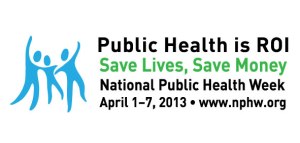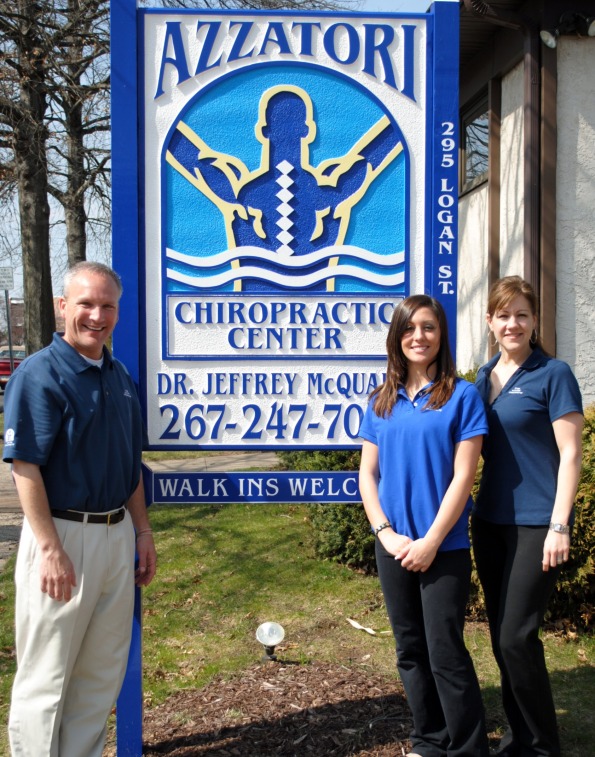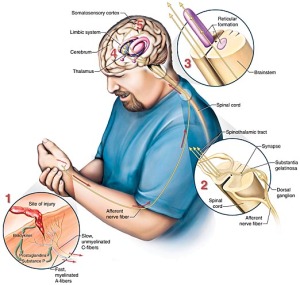Archive
Dr. Jeff McQuaite and his team at Azzatori Chiropractic-Doylestown proudly recognizes National Public Health Week 2013 by promoting this year’s theme, “Public Health is ROI: Save Lives, Save Money.”
Every year in the United States, including Doylestown and the surrounding Central Bucks communities, statistics show that seven out of 10 deaths are due to preventable chronic diseases such as diabetes and heart disease (2). In fact, chronic diseases account for a whopping 75 percent of national health care spending, yet only 3 percent of our health care dollars go toward prevention (3).
But there are steps we can take to help turn these statistics around.
Dr. Jeff McQuaite, a chiropractor in Doylestown, is ready to provide key support to patients who are trying to create healthy working environments. This comes as communities across the country this week observe National Public Health Week (NPHW), which promotes creating a healthy workplace on Wednesday, April 3.
The theme of NPHW 2013—“Public Health is ROI: Save Lives, Save Money”—promotes the value of prevention and the importance of well-supported public health systems in preventing disease, saving lives and curbing health care spending. For more than 100 years, the chiropractic profession has promoted prevention as a key component of health and wellness, and a growing body of research shows that chiropractic services reduce health care spending. Research shows that investing just $10 per person each year in proven, community-based public health efforts can save the nation more than $16 billion within five years. That’s a $5.60 return for every $1 invested(4).
“We all have a role to play in making our communities healthier places and Azzatori Chiropractic-Doylestown is excited to help lead the way. Many small preventive steps can add up to make a big difference in transforming a health care system focused on treatment to one that equally values prevention.”
“Our nation and community simply cannot sustain the current trajectory of health care spending and chronic disease rates,” said Dr. Jeff McQuaite “Fortunately, we know that investing in prevention and public health can make an enormous difference.”
Dr. Jeff emphasized that supporting public health approaches to better health does reap life-saving returns.
For example, research shows that each 10 percent increase in local public health spending contributes to a nearly 7 percent decrease in infant deaths, a 3.2 percent decrease in cardiovascular deaths and a 1.4 percent decrease in diabetes-related deaths(5). Public health and prevention are critical pieces in creating a healthier nation.
According to the U.S. Bureau of Labor Statistics, in 2011 musculoskeletal disorders made up 33 percent of all work-related injury and illness cases. When considering the impact of proper ergonomics on workplace safety, this Doylestown chiropractor and the ACA stresses three basic principles:
1. When lifting, the largest muscles in the area should perform the task. The larger the muscle or muscle group used for lifting, the lower the stress on smaller, more vulnerable muscles.
2. During any work activities, people should be able to comfortably assume a number of different postures and not remain in one position for an extended time. Muscles will fatigue and be more prone to injury when assuming a particular posture, especially a poor one (e.g., partially bent forward at the waist).
3. When performing tasks, it is important to keep the joints either in their neutral posture or approximately halfway into the range of motion. Working with your joints at the extremes of their ranges of motion for prolonged periods places abnormal stresses on them and can cause repetitive stress injuries.
“Our bodies are not designed to maintain the same posture for long periods of time or to repeat the same motions endlessly,” said ACA President Keith Overland, DC. “Stretches and exercises can help prevent pain and injury. There are also natural, cost-effective approaches to treating pain, such as chiropractic services, that can help patients avoid unnecessary drugs or surgery.”
This information is part of the American Public Health Association’s annual celebration of the role of public health and prevention in our communities. Since 1995, communities nationwide have celebrated NPHW each April to draw attention to the need to help protect and improve the nation’s health.
“National Public Health Week helps educate and engage Americans in the movement to create a healthier America for ourselves and the generations to come. The hundreds of events that take place this week help showcase the value of supporting prevention and the role that public health agencies, organizations and practitioners play in making prevention possible,” said Georges C. Benjamin, MD, FACP, FACEP (E), executive director of the American Public Health Association.
“We all have a role to play in making America the healthiest nation in one generation. And it starts with each of us taking the simple preventive steps that lead to better health.”
For more information about National Public Health Week, visit http://www.nphw.org. To learn more about Azzatori Chiropractic-Doylestown and their public health efforts in your community, visit http://www.mcquaitechiropractic.com
Azzatori Chiropractic-Doylestown
295 Logan Street
Doylestown, PA 18901
267-247-7000
2 Kung HC, Hoyert DL, Xu JQ, Murphy SL. Deaths: final data for 2005. National Vital Statistics Reports 2008;56(10). Available from: http://www.cdc.gov/nchs/data/nvsr/nvsr56/nvsr56_10.pdf
3 APHA. The Prevention and Public Health Fund: A critical investment in our nation’s physical and fiscal health. June 2012. Available at: http://www.apha.org/advocacy/reports/reports
4 Levi, J. et al, Prevention for a Healthier America: Investments in Disease Prevention Yield Significant Savings, Stronger Communities. Trust for America’s Health. Feb. 2009.
5 APHA Infographic available at: Action.apha.org/site/PageNavigator/Infographic_Page_2012_10_04_Round_2.html.
Doylestown Chiropractor Having “Spring Into Good Health” Community Appreciation Week!
Dr. Jeff McQuaite and his team at Azzatori Chiropractic-Doylestown are celebrating their 1st anniversary at their location in Doylestown by having a “Spring Into Good Health” Community Appreciation Week from April4-8, 2011!
Dr. McQuaite and his team are asking that you please join them with your family and friends as they celebrate their 1st anniversary in Doylestown. “This past year we have met many wonderful people who have become friends and patients, seen some amazing results and have had tremendous growth!” “As our way of saying “THANKS”, we will be having a full week of free and discounted services, fun, food and prizes!”
All new patients will receive:
$20 Exam, X-rays & Treatment
Free 30 minute massage
Discounted massages for the month of April
Sign-ups for special events
Much, much more!
Dr. Jeff McQuaite has been helping the residents of Central Bucks rediscover a life without pain for over 15 years. He has distinguished itself from other practices by offering a more wellness based approach to their health care. “I am striving to get my patients to understand the importance of corrective care and to be more proactive than reactive in regards to their health.” “That is why we are called a TEAM. We Teach our patients, Educate our patients, Adjust our patients and Motivate them to be active participants in their health care.”
Dr. Jeff says that “this type of care is geared towards those individuals who are looking for a more permanent solution to chronic aches and pains.” Patients with complaints of pain in the neck, lower back and hips, or even those with recurring headaches and dizziness, are given a comprehensive chiropractic program that is customized to their specific needs with the end goal of long-term recovery.
It all starts off with high frequency x-ray imaging where the doctor takes a close look at the state of your spine and compare your spine’s shape and form to that of a normal healthy spine. This allows him to focus in on the main problem areas. The gentle treatments offered at his office consists of conservative chiropractic adjustments, traction, ice/heat therapy, massage and other rehabilitative methods in order to slowly but steadily bring your body back to healthy alignment. The doctor will customize the treatment based on the individual and will also offer life style modification, exercises and stretching techniques that the patients can do at home to further along the process.
For more information, please call:
Azzatori Chiropractic
295 Logan Street
Doylestown, PA 18901
267-247-7000
Azzatori Chiropractic of Doylestown Announces Their Adopt a Family Donation Drive!
This holiday season, Dr. Jeff and his team at Azzatori Chiropractic-Doylestown are partnering with the Bucks County Opportunity Council in support of their annual “Adopt-a Family” program. Beginning November 12th and running through December 3rd, our office will be collecting items requested by a family in need of assistance at this special time of year. We are asking for your help in this endeavor. We will display a “giving tree”, with ornaments listing specific items for each member of the family. All you have to do is take an ornament, purchase the item, and bring it unwrapped to the office, it’s that simple. If you prefer, cash donations will be accepted and we will purchase the gifts on their wish lists.
Along with the donation drive, we will be offering a New Patient special at the “Adopt-a-Family” rate of $20, which will be donated to the Opportunity Council to assist the program. This includes a consultation with Dr. Jeff McQuaite, 2 x-rays, and treatment. What a great time to refer your friends and family to our office!
We are proud to be one of THE BEST chiropractic offices around, and we want to share our blessings we have received this year with those less fortunate. We hope we can count on your generosity to help us as we look forward to a wonderful outcome!
Our “Adopted” family is a single mother, 29 years old with 3 children; 9 year old daughter, 6 year old daughter and a 2 year old son.
Dr. Jeff, Courtney, Pam, Tina and Arielle
Azzatori Chiropractic
295 Logan Street
Doylestown, Pa. 18901
267-247-7000
Doylestown Chiropractor Gives Healthy Tips For Halloween
With the chance to dress up in costume and stock up on sweets, Halloween is the highlight of the year for many kids — from toddlers to teens.
But since it’s high season for candy, it can also be an exasperating time for parents who encourage kids to eat healthy foods and make sweets a limited part of a balanced and nutritious diet.
For health-conscious parents, Halloween can be tricky. Do you set limits? Do you let kids decide how much to eat? There isn’t just one right answer. Instead, use your best judgment given what you know about your child’s personality and eating habits.
On the one hand, you want to let kids indulge and enjoy the holiday. On the other, you don’t want to undermine all the work you do the rest of the year maintaining a balanced diet and a healthy lifestyle. And you don’t want to confuse kids with mixed messages.
“Building a healthy lifestyle for your family means making smart choices 365 days a year,” said Anita Harvey, executive director of the YMCA’s Broadway branch, “and Halloween is a great opportunity to focus your family’s attention on physical activity and eating habits and to demonstrate that ‘everything in moderation’ doesn’t mean it’s OK to eat candy until you’re sick to your stomach.”
Use your best judgment given what you know about your child’s personality and eating habits. Before kids go trick-or-treating, try to serve a healthy meal so they’re not hungry when the candy starts coming in.
Kids who generally eat just a couple of pieces and save the rest might be trusted to decide how much to eat. But if your child tends to overdo it, consider setting limits.
Here are some more tips for handling the Halloween treats:
- Know how much candy your child has collected and store it somewhere other than the child’s room. Having it so handy can be an irresistible temptation for many kids.
- Consider being somewhat lenient about candy eating on Halloween, within reason, and talk about how the rest of the candy will be handled. Candy and snacks shouldn’t get in the way of kids eating healthy meals.
- If a child is overweight — or you’d just like to reduce the Halloween stash — consider buying back some or all of the remaining Halloween candy. This acknowledges the candy belongs to the child and provides a treat in the form of a little spending money.
- Be a role model by eating Halloween candy in moderation yourself. To help avoid temptation, buy your candy at the last minute and get rid of any leftovers.
- Encourage your child to be mindful of the amount of candy and snacks eaten — and to stop before feeling full or sick.
- Just because it’s Halloween doesn’t mean that all of the treats must be chocolate and sugar-loaded. Alternative treats include pretzels, granola bars, raisins and juice boxes.
Many parents said that after letting kids indulge in some treats right after trick-or-treating, they limit their kids to a certain number of pieces each day or put the candy stash out of reach and out of sight. Then kids have to ask for it — that is, if they remember that it’s there!
Azzatori Chiropractic-Doylestown
295 Logan Street
Doylestown, Pa. 18901
267-247-7000
Doylestown Chiropractor Celebrates National Chiropractic Health Month
Is Pain Your Obstacle to Fitness? Chiropractic Can Help
Are aches and pains getting in the way of your weight loss goals? Jeffrey McQuaite, DC, of Azzatori Chiropractic, a Doylestown doctor of chiropractic can help. This fall, doctors of chiropractic across the country will highlight how they can help patients focus on getting past the roadblocks to fitness and better health during National Chiropractic Health Month. The theme for the 2010 observance is “Why Weight? Get Healthy!”
More than 60 percent of adults in the United States are either overweight or obese, according to CDC statistics, and obesity is associated with an increased risk of diabetes, hypertension, heart disease, and some types of cancer. However, many people are unaware that even modest weight loss, such as 5 to 10 percent of a person’s total body weight, could improve blood pressure as well as blood cholesterol and blood sugars levels. That’s only 10 to 20 pounds for a person who weighs 200 pounds.
Yet losing weight can be a struggle, and many people wonder where to begin. The answer for some may be in the office of a doctor of chiropractic (DC). “Diet pills and extreme diets do not offer long-term solutions,” says Dr. Rick McMichael, president of the American Chiropractic Association. “Doctors of chiropractic, on the other hand, offer natural approaches such as exercise, diet and hands-on care to help keep you active and able to achieve your weight-loss goals in the short term, and also help you maintain your fitness level and thereby avoid some chronic conditions down the line.”
Consultation with a DC is particularly important when you consider that the effects of obesity on the musculoskeletal system—osteoarthritis, back pain, neck pain and joint pain—often cause overweight people to avoid physical activity and exercise when they need it most.
“If you’re carrying more weight than the load-bearing structures of your body—spine, legs, etc.—can handle, there’s going to be pain, loss of movement and degeneration in the joints,” adds Dr. McQuaite. “Particularly if you’re carrying most of your weight in your abdomen, the low back and the spine will need to work harder to hold you upright. This adds extra stress and tension on your muscles, which in turn creates stiffness.”
Sponsored by ACA, National Chiropractic Health Month is held each October. The event helps raise public awareness of the benefits of chiropractic care and its natural, whole-person, patient-centered approach to health and wellness.
In conjunction with this special month and the Community Wellness Day we were a part of, we are offering our initial visit, which includes 2 x-rays, exam and treatment for $20, which will then be donated to A Women’s Place.
Dr. Jeff McQuaite has been helping the residents of Doylestown, Jamison, Warrington, Buckingham and the entire Central Bucks region rediscover a life without pain for over 15 years.
Azzatori Chiropractic
Dr. Jeff McQuaite
295 Logan Street
Doylestown, Pa. 18901
267-247-7000
Chiropractic and pain relief
Dr. Jeff McQuaite, a Doylestown Chiropractor, has found a new study demonstrating chiropractic’s effectiveness in relieving pain. This new study added more information to the way we understand how chiropractic adjustments help the brain with pain relief. The New Zealand College of Chiropractic study focused on people with a history of reoccurring neck stiffness and/or neck pain but showed no acute symptoms at the time of the study. The subjects were hooked up to computers that read brainwaves, and were given chiropractic adjustments. When they were adjusted, the computers showed that parts of the brain where pain and suffering occurs had less activity. These findings may help to explain the mechanisms responsible for the effective relief of pain and restoration of functional ability documented after spinal manipulation treatment.
2% of Prescriptions Filled Are Not Approved By The FDA
Doylestown Chiropractor, www.mcquaitechiropractic.com, via Dr. Gary Puckrein, Special to AOL News.
Each day, about two out of every 100 prescriptions filled at pharmacies around the country are for drugs that have never — repeat, never — been approved by the Food and Drug Administration.
These unapproved drugs often make unsubstantiated claims not supported by scientific data or laboratory testing. Many of them are wrongly deemed safe and are often incorrectly labeled as “generics.” None of them has ever seen the light of an FDA laboratory.
As a result, patients often end up taking drugs unaware that by doing so they are putting themselves at risk of a dangerous side-effect or potentially life-threatening adverse drug interaction.
Here in the 21st century, in the country with the best health care in the world, where patients assume that any prescription drug has been cleared by the FDA, it’s hard to imagine that this goes on. But it does.
To respond to patient concerns over the potential dangers of taking unapproved drugs, the FDA established its Unapproved Drugs Initiative in 2006. This important step specifically encourages pharmaceutical companies to get their unapproved drugs into the agency’s pipeline for testing and, if found to be safe and effective, approved. And to encourage drug companies to do so, the FDA also started removing unapproved drugs from pharmacy shelves.
To date, however, many remain.
Especially troubling are the unapproved drugs that remain on the market and are used by unsuspecting patients, even though a tested, safe and FDA-approved alternative is available. For example, versions of oxycodone, thyroid medication, ephedrine, codeine, acetaminophen, hydrocodone, colchicine, nitroglycerin and morphine have been approved; yet, dozens of unregulated versions of these drugs are still available.
The FDA’s stamp of approval is backed by its unmatched pharmacological drug analysis and testing procedures, which implant the world’s gold standard to any FDA-approved drug.
It gives patients and doctors the assurance that their medicine was made using the best ingredients, with sterile equipment, packaged in safe and tamper-resistant containers, and will act as predictably as science can determine. It guarantees that each product is properly labeled to reduce the risk of adverse reactions but also recorded and tracked so that any side effects can be properly cataloged and used for further study.
Conversely, unapproved drugs fly under the agency’s radar, so adverse reactions remain unknown — allowing preventable reactions to go unexposed, waiting to claim other potential victims.
Recently, regulators have signaled they are willing to re-engage and reprimand companies that produce, distribute and sell unapproved drugs. The FDA is sending letters to manufacturers of some of these illicit products urging them to stop producing, distributing and selling them. This must continue, since patients and many doctors incorrectly believe that if a drug is readily available, it must be FDA approved.
Public and private sectors alike need to work together to ensure a safe and effective prescription drug supply. Policymakers, physicians and other health care professionals, patients, the pharmaceutical industry and drug store chains should all work together to ensure that the prescriptions people take will heal them — not harm them. Physicians should not write prescriptions for unapproved drugs, especially when ones already cleared by the FDA are available.
Patients can visit Drugs@FDA or the Did You Know Project to learn more about approved and unapproved drugs. They can also ask their doctors and their pharmacists about their medications to ensure they are FDA approved and won’t interact with their other treatments. Ultimately, drug store chains and distributors should clean their aisles of unapproved drugs.
Until unsafe, unapproved and potentially harmful drugs are taken out of the marketplace, there will always be the risk that another patient will lose her life, unnecessarily, because we didn’t do enough.
Stress, Tax Season & Massage!
What are the health consequences of the tax season burden on American taxpayers?
by Mike Adams, the Health Ranger, NaturalNews Editor, Dr. Jeff McQuaite, Doylestown Chiropractor
It’s tax season in the U.S. again, and when it comes to discussions about the financial burden on the economy from the complexity of the current U.S. tax code, most of the criticisms focus on the number of dollars (or hours) spent in compliance. According to a study from the Tax Foundation, U.S. taxpayers spend over 6 billion hours and over $256 billion working to comply with the current tax code. That’s a lot of dollars and hours, but it may pale in comparison to yet another cost: The health consequences of the stress caused by the U.S. tax code.
Preparing your taxes is stressful for lots of reasons. First, there’s just the time and frustration in trying to track down receipts, fill out the forms and even translate IRS instructions into plain English. Nobody in their right mind enjoys this job, and it takes a toll on human physiology. Stress causes immune suppression, for one thing. Adrenal depletion can result in hormonal disorders, sleep disorders and even an increased risk of heart attacks.
But that’s just the beginning of the story. The greater cost in tax code compliance may come from the fear factor.
The U.S. tax code, you see, is enforced in large part by fear: Fear of an audit, fear of arrest, fear of making an honest mistake that gets you into trouble. Even when you make a full-on attempt to prepare your taxes as honestly and accurately as you can, it’s a well-known fact that no two accountants will ever arrive at the same dollar figure that you owe. So how can there be a “right” answer on your taxes? And if nobody is right, then everybody must be wrong… right? And being wrong can get you into trouble. So this fear of making a mistake takes another huge toll on your physiology.
Taxes are taxing to your health, too.
To my knowledge, no one has made any scientific attempt to calculate the health costs of tax code compliance. But it’s not difficult to imagine that the additional stress and fear that is placed upon every American by the IRS must have some sort of measurable cost in terms of additional health care expenses. Those health care expenses, ironically, are often paid for by taxpayers.
So we are paying for ourselves to be stressed out and then possibly end up in the hospital where we cover each other’s health care costs by paying the very taxes that stressed us out in the first place.
What’s wrong with this picture?
But now for some good news! You may very well have been getting a tax-deductible massage and did not know it. Yes, that’s correct! Your massage therapy may very well be tax deductible.

Many deductions, such as medical expenses, require you to overcome a minimum. For example, only medical expenses that exceed 7.5% of your adjusted gross income are allowed. This means an individual with an adjusted gross income of $40,000 can only deduct medical expenses above and beyond $3,000.
Your medical care expenses typically include medical insurance, some Medicare costs, and miscellaneous costs of health care. These could include costs for making alterations to your home prescribed for your medical condition, removing toxic substances from your home, enrolling in weight-loss programs, dental work, and travel-related expenses to get to your medical care, including mileage expense. Even that massage you got to relieve stress MAY be deductible. Other potentially deductible expenses include prostheses, and ointments or lotions for wound and skin care.
Deductible medical services can be performed by someone other than your doctor. If you have a condition like a bad back and your doctor says you need regular massage, this treatment is deductible. Make sure you get a prescription for massage from your doctor saying you need these services.
Remember that the cost of the massage therapy is TAX DEDUCTIBLE as long as a physician prescribes it.
If you routinely get massage to help manage stress, blood circulation, chronic pain, or other medical conditions ask your doctor for a prescription and get a receipt for each massage from your massage therapist.
Doylestown Chiropractor, Botox for headaches?!?
FDA Approves Botox for Elbow Spasms. Are Migraines Next?
By MELLY ALAZRAKI
03/10/10 Company News, Healthcare
The Food and Drug Administration on Tuesday approved Allergan’s (AGN) wrinkle-smoothing drug Botox to treat elbow, wrist and finger spasms. Spasticity in the flexor muscles, common after stroke, traumatic brain injury or the progression of multiple sclerosis, afflicts 1 million Americans, many in their upper limbs, according to Allergan, based in Irvine, Calif. (Botox does not affect darkened elbow skin and folds.)
“Muscles affected by spasticity have increased stiffness and tightness, which may lead to pain, difficulties with hygiene and other activities of daily living, and may affect how a patient looks,” says Dr. Russell Katz, director of the Division of Neurology Products in the FDA’s Center for Drug Evaluation and Research. Botox, injected into the affected muscles, blocks the connections between nerves and muscles, paralyzing the spastic muscle for an average of up to three months in clinical trials.
Sweating, Spasm…and Migraines?
Because the active ingredient in Botox is the highly poisonous botulinum toxin, the FDA last year required Allergan to warn that the effect of Botox could spread from the area of injection to other areas of the body, causing symptoms similar to those of botulism, including potentially life-threatening difficulty with swallowing and breathing.
The FDA further stressed that Botox has not been proved a safe, effective treatment for larger muscles such as those in the legs and others in the upper limbs. Nor is it safe for treatment of fixed contracture, a condition that affects range of motion. The most common adverse reactions were nausea, fatigue, bronchitis, muscle weakness and pain in the arms.
Although better known for its cosmetic applications, Botox is approved to treat such therapeutic conditions as underarm sweating, neck spasms, and eye-muscle disorders. Therapeutic sales of Botox accounted for approximately 52% of Allergan sales last year and increased about 4% over 2008. Cosmetic sales accounted for approximately 48% and decreased approximately 4%. Allergan is testing Botox for other medical uses, including migraines, which may be the most significant area for the drug’s future sales growth.
‘Off-Label’ Treatments
While Botox’s FDA-approved uses may be limited, doctors are allowed to prescribe it in unapproved (“off-label”) treatments for muscle spasms. But pharmaceutical companies are prohibited from promoting off-label uses. Last year, Eli Lilly (LLY) paid a $1.42 billion fine, and Pfizer (PFE) paid a record $2.3 billion fine, to settle charges of off-label promotions.
Allergan has sued the FDA, arguing that these rules violate its First Amendment right to free speech. It wants to be allowed to “share relevant information with the medical community on the safe use” of Botox for off-label uses. Tuesday’s approval, demonstrating that the FDA doesn’t hold a grudge, eases investors’ concerns on that front. Botox sales rose 5.6% last quarter, to $347.7 million, and Allergan forecasts full-year 2010 net sales of $1.33 billion to $1.37 billion. Allergan shares rose some 1.8% in morning trading.
While therapeutic uses may continue to fuel increases, cosmetic uses may too: Despite the recession, plastic surgeries declined only 2% in 2009 — nearly 10 million procedures in the U.S. included 2.5 million procedures involving botulinum toxin type A (whether Botox or rival Ipsen Group’s Tercica’s Dysport).
Doylestown Chiropractor, Weight Watchers says eat at McDonald’s to lose weight?!?
Weight Watchers says eat at McDonald’s to lose weight (opinion)
by Mike Adams, the Health Ranger, NaturalNews Editor
Weight Watchers has now officially endorsed Chicken McNuggets as a “healthy meal” in New Zealand, where McDonald’s restaurants will begin carrying the Weight Watchers logo on several menu items. This bizarre and inexplicable decision has now made Weight Watchers the laughing stock of the health world where nutrition and weight loss experts normally don’t use “McDonald’s fast food” and “weight loss” in the same sentence.
As The Guardian reports, “As part of the deal, which the company says is the first of its kind in the world, McDonald’s will use the Weight Watchers logo on its menu boards and Weight Watchers will promote McDonald’s to dieters.”
Nutritionists, not surprisingly, were shocked at the announcement. The idea of eating at McDonald’s to lose weight seems a bit ridiculous, and anyone who believes that eating Chicken McNuggets will cause you to lose weight is arguably one nugget short of a Happy Meal. Sometimes you just have to point out the stupidity of these things, even at the risk of offending someone who has convinced themselves that eating more Chicken McNuggets is their ticket to a slim, fit and sexy body.
Watch your weight balloon!
Weight Watchers, by the way, never actually claims that eating the foods they endorse will cause you to lose weight. If you examine it carefully, even their name isn’t really about weight loss. It’s about weight watching… as in, watch your weight grow larger by the day…
A “weight watch” is sort of like a “tornado watch” or a “tsunami watch.” You keep your eyes peeled and wait for something disastrous to happen — such as ballooning to 300 pounds while engaging in unhealthy eating McHabits based on snarfing down meat parts from factory-farmed cows raised in bovine concentration camps that might more accurately be called “Cowschwitz.”
If Weight Watchers is going to endorse McNuggets, then why not just endorse the entire McDonald’s menu and throw the logo behind Big Macs and ice cream shakes, too? It’s not like Weight Watchers is trying to “protect its reputation” by not crossing a line, you know. Once you’ve endorsed McDonald’s as “healthy” food, that line is no longer anywhere in sight.
Of course, McDonald’s products merely join a long list of questionable foods marketed under the “Weight Watchers” brand name — a brand that in my opinion has discovered great commercial success in selling the false hope of weight loss to clueless consumers who are unwilling to read ingredients lists on food labels.
Not coincidentally, Weight Watchers has now become the “McDonald’s” of the weight loss industry — and industry filled with so many scams and shams that the idea of eating Chicken McNuggets to lose weight doesn’t even seem that strange to many people.
We live in a world where corporate promotional lies are disgusting at best, and criminal at worst. We’re told that psychiatric drugs will make you happy, that chemotherapy will make you healthy and that eating at McDonald’s will make you lose weight. We’re told that sugary junk drinks will give you “energy”, that toxic vaccines are necessary for your immune system to work correctly and that buying silly pink-ribbon products will somehow cure cancer.
At the same time, we’re told that vitamins are dangerous, that sunlight causes cancer and that there’s no such thing as a cure for type-2 diabetes. Everything that’s good for you is discredited as bad while everything that’s toxic is hyped up as “healthy.”
I suppose in light of the corporate-sponsored sick-care insanity that passes for medical advice these days, the idea that eating at McDonald’s will make you lose weight doesn’t seem as insane as it really should.
But that doesn’t make it any more true.
In a world gone mad with dietary misinformation touting fictional foods, insanity can now be marketed to the intoxicated mainstream as if it somehow made sense.
… and people swallow it.
Sources for this story include:
http://www.guardian.co.uk/business/…










